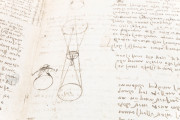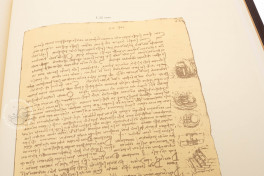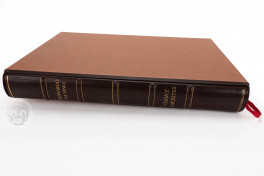The Codex Hammer, also known as the Leicester Codex, is a remarkable manuscript attributed to Leonardo da Vinci. Compiled between 1506 and 1513, during Leonardo's time in Florence and Milan under the patronage of the French king Louis XII, the codex stands out among Leonardo's other manuscripts due to its focused exploration of a single theme: the study of water. The book comprises meticulously handwritten pages presenting Leonardo's observations, theories, and sketches.
The manuscript constitutes a significant document that consolidates Leonardo's scattered notes and observations, demonstrating his intention to create a comprehensive treatise on various scientific subjects.
Leonardo's Aquatic Exploration
Unlike the artist's other notebooks, which encompass a wide range of subjects, the Codex Hammer is predominantly dedicated to in-depth investigations of various aspects related to water. Its pages are filled with intricate illustrations and accompanying texts that delve into currents, whirlpools, waves, canals, dams, and numerous projects involving the use of water for energy generation and military purposes.
Da Vinci's meticulous handwriting is accompanied by intricate sketches and diagrams, meticulously drawn by the artist himself. These visual representations enhance the text, providing visual clarity to his scientific explanations. The illustrations exhibit Leonardo's keen eye for detail and his unparalleled ability to capture the essence of natural phenomena.
A Blend of Scientific Knowledge and Artistic Sensibility
As for its structure, the manuscript is divided into sections that explore different aspects of water and its effects on the natural world. Each section begins with a descriptive title that provides a glimpse into the subject matter discussed within. Leonardo's aim was to create an organized work, drawing from his accumulated notes and real-life experiences to produce a scientific encyclopedia.
Da Vinci's scientific writings in the Codex Hammer employ a combination of precise technical terminology and expressive descriptions. The language possesses a poetic quality and, by blending scientific observations with artistic sensibility, it makes the text both scientifically rigorous and aesthetically engaging.
A Manuscript's Journey
While it was likely not among the manuscripts inherited by Francesco Melzi, Leonardo's pupil and heir, the Hammer Codex is believed to have belonged to Giovanni della Porta, a sculptor and student of Michelangelo. Later on, the codex came into the possession of Thomas Coke, Count of Leicester, who housed it in the library at Holkham Hall for over two centuries. It was later auctioned and acquired by the American magnate Armand Hammer, and eventually found its way into the collection of Bill Gates, who remains its custodian today.
We have 3 facsimiles of the manuscript "Codex Hammer":
- Codice Leicester facsimile edition published by Art Market, 1981
- Codice Leicester facsimile edition published by Collezione Apocrifa Da Vinci, 2013
- Codice Hammer facsimile edition published by Giunti Editore, 1987




















